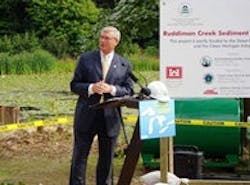Ruddiman Creek Sediment Cleanup Underway
Work has begun on the $10.6 million U.S. Environmental Protection Agency and Michigan Department of Environmental Quality cleanup of Ruddiman Creek and Pond in Muskegon, Mich. Current activities will prepare the way for the removal of about 80,000 cubic yards of contaminated sediment from the creek and pond, the first such cleanup in the Muskegon Lake Area of Concern. The project is expected to last nine months.
At an event in Muskegon's McGraft Park to celebrate the start of the project, EPA Administrator Stephen L. Johnson congratulated members of the local public advisory council on their commitment to this project. "These funds from the President's Great Lake Legacy Act will help create a tangible legacy for the environmental well-being of the area," commented Administrator Johnson. "Because of this work, the residents of Muskegon can again enjoy a safe natural environment."
"The Michigan Department of Environmental Quality is pleased to be a part of this partnership that will see this area restored to its natural beauty," said Michigan DEQ Director Steven E. Chester. "This is truly an example where federal, state, and local efforts have jointly created a positive impact on Michigan's environment that will be enjoyed for generations to come."
Currently, the main branch of the creek is posted as a no swimming, fishing or recreation area because the sediment is contaminated with polychlorinated biphenyls (PCBs), polyaromatic hydrocarbons (a byproduct of petroleum) and toxic metals such as chromium, cadmium and lead. After removal, contaminated sediment will be hauled by truck to a licensed landfill near Muskegon, and sampling will be done during and after the project to make sure contamination levels are reduced.
EPA and Michigan DEQ developed the cleanup plan in partnership with the local public action committee. The goals of the cleanup are to reduce risks to health, wildlife and aquatic life, restore aquatic habitat and enhance the recreational, residential and economic values of the area. After the cleanup, the creek and pond water flow patterns will be restored, followed by replanting of native species of flowers, trees and grasses.
The Great Lakes Legacy Act will provide 65% or $6.9 million and Clean Michigan Initiative the remaining 35% or $3.7 million of the cost of the cleanup. It is the third project to receive money under the Great Lakes Legacy Act, which President Bush signed in 2002 to address the problem of contaminated sediment in 31 toxic hot spots known as "areas of concern" around the Great Lakes.
Contaminated sediment is a problem in rivers and harbors throughout the Great Lakes. It is a reason why many fish in the lakes are not safe to eat in unlimited quantities, harms aquatic life, degrades habitat and affects the quality of sources of drinking water. For more information about this cleanup go to: http://www.epa.gov/glla/ruddiman.
Source: EPA
